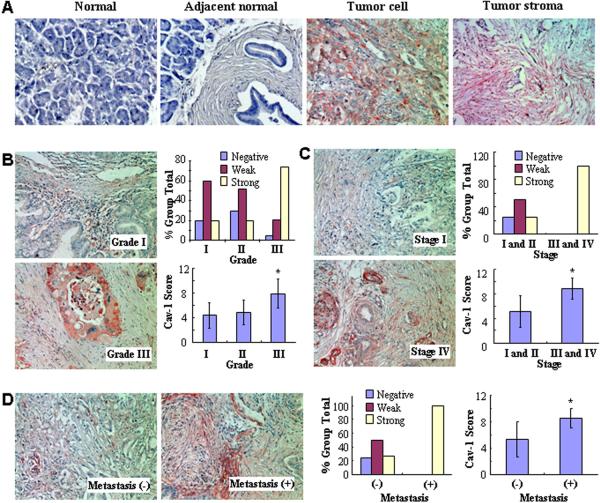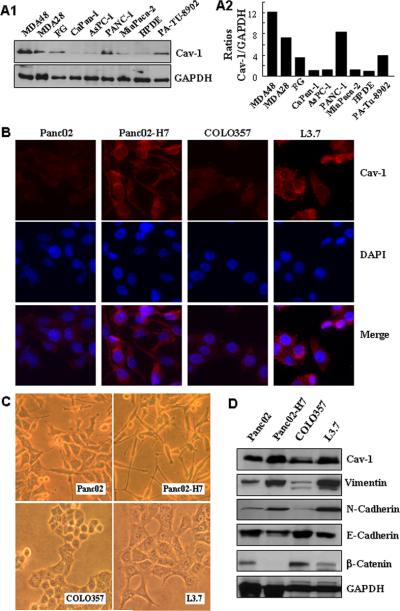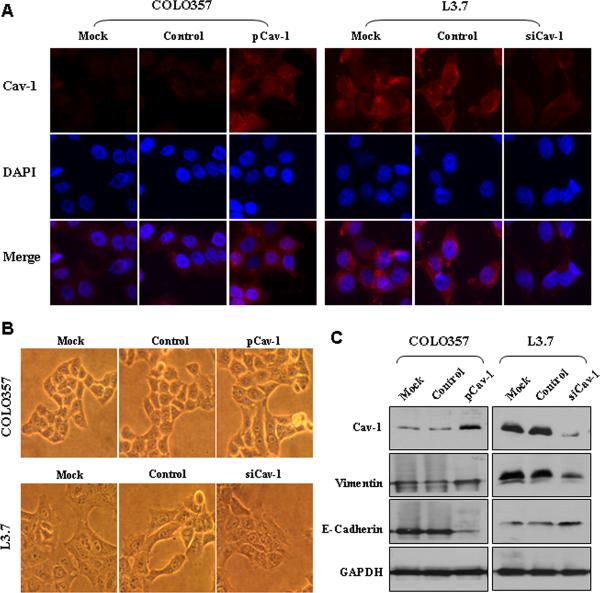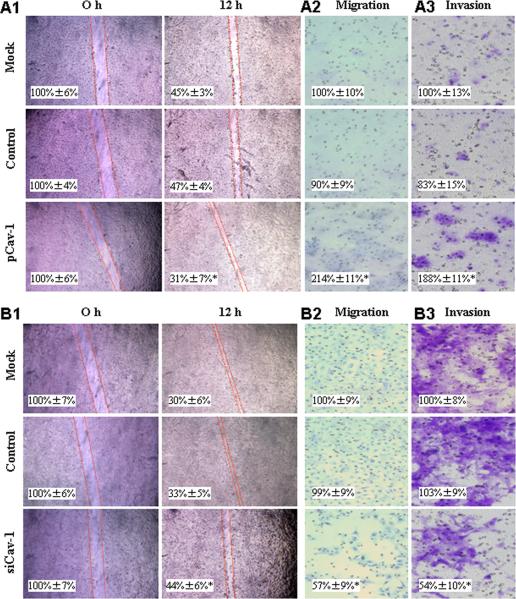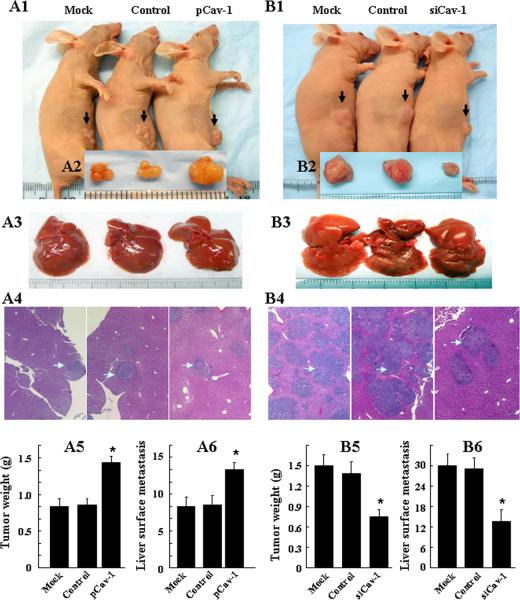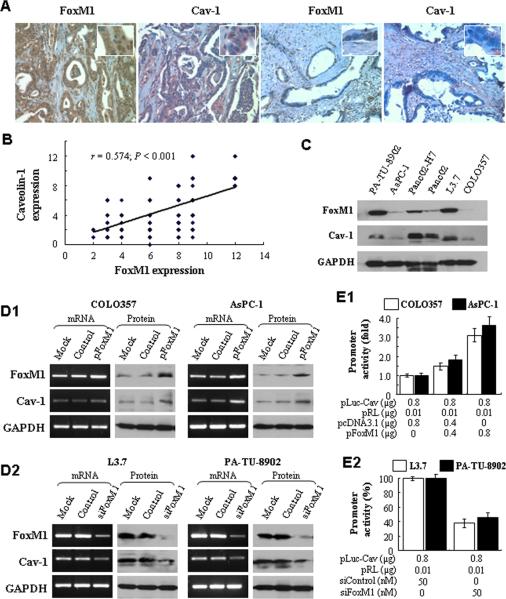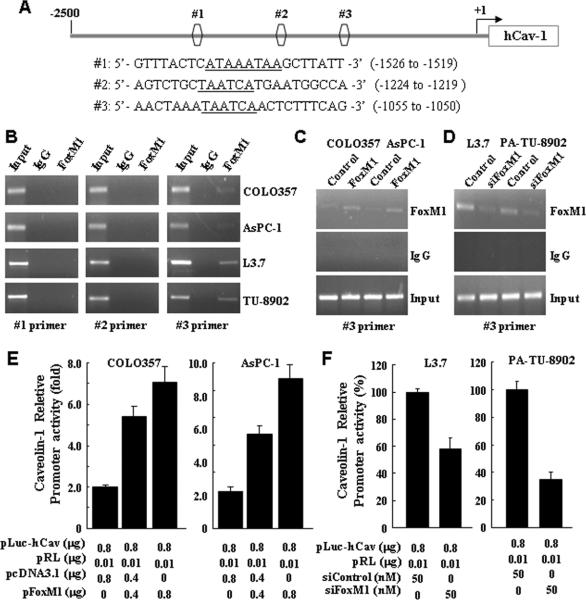Abstract
Caveolin-1 (Cav-1), a principal structural component of caveolar membrane domains, contributes to cancer development but its precise functional roles and regulation remain unclear. In this study, we determined the oncogenic function of Cav-1 in preclinical models of pancreatic cancer and in human tissue specimens. Cav-1 expression levels correlated with metastatic potential and epithelial-to-mesenchymal transition (EMT) in both mouse and human pancreatic cancer cells. Elevated levels in cells promoted EMT, migration, invasion and metastasis in animal models, whereas RNAi-mediated knockdown inhibited these processes. We determined that levels of Cav-1 and the Forkhead transcription factor FoxM1 correlated directly in pancreatic cancer cells and tumor tissues. Enforced expression of FoxM1 increased Cav-1 levels, whereas RNAi-mediated knockdown of FoxM1 had the opposite effect. FoxM1 directly bound to the promoter region of Cav-1 gene and positively transactivated its activity. Collectively, our findings defined Cav-1 as an important downstream oncogenic target of FoxM1, suggesting that dysregulated signaling of this novel FoxM1-Cav-1 pathway promotes pancreatic cancer development and progression.
Keywords: Progression, angiogenesis, transcription factor, EMT, biomarkers
Introduction
Pancreatic cancer represents one of the leading causes of cancer deaths in industrialized countries, with an estimated 43,140 new cases and 36,800 deaths occurring annually in the United States (1). At presentation the disease has, in most cases, already spread locally and to distant organs that precludes a resection, and only about 5%–25% of cases constitute candidates for surgical resection. Among patients undergoing a potentially curative resection, the long-term outcome remains unsatisfactory due to early recurrence and metastatic disease (2). Effective systemic therapy capable of reversing the aggressive biology of this disease is currently not available. Therefore, there is an urgent need for a better understanding of the molecular mechanisms underlying pancreatic cancer pathogenesis (3,4).
Cav-1 is the major structural protein in caveolae; 50- to 100-nm omega-shaped invaginations of the plasma membrane. Caveolae are involved in signal transduction, wherein Cav-1 acts as a scaffold to organize multiple molecular complexes regulating a variety of cellular events (5). Recent studies have suggested that Cav-1 may play important roles in cancer development and progression (6–10). Paradoxically, Cav-1 appears to impact both positively and negatively on cancer biology (6), although recent studies suggest a positive association between Cav-1 expression and pancreatic cancer poor prognosis (11–13). Specifically, tumor cells in pancreatic cancer show significantly higher Cav-1 expression relative to tumor stroma and Cav-1 knockdown significantly induces cell apoptosis and enhances the radiosensitivity of pancreatic cancer cells (14,15). Furthermore, Cav-1 expression could be detected in the fibroblasts of the desmoplastic pancreatic cancer stroma, but not in stromal cells of the normal pancreas. Importantly, co-expression of Cav-1 and fatty acid synthase significantly correlates with clinical features and survival status of pancreatic cancer patients, demonstrating that Cav-1 and other factors may functionally cooperate in the process of pancreatic tumorigenesis (16). All of this experimental and clinical evidence supports that Cav-1 is an oncogene in pancreatic cancer and may be good candidate prognostic markers and targets for therapeutic intervention. Interestingly, researchers have demonstrated Cav-1 expression can be up-regulated during EMT, and further, once expressed, Cav-1 can influence cancer cell motility (17). Moreover, Cav-1 overexpression increased motility and invasion of human hepatocellular carcinoma cells through down-regulation of E-Cadherin while up-regulation of Vimentin, demonstrating the important roles of Cav-1 in EMT and metastasis of human cancer (18). However, the precise function and underlying mechanisms of Cav-1 in pancreatic cancer EMT and metastasis remain unclear and how Cav-1 expression is regulated is unknown.
FoxM1, a transcription factor of the Forkhead box (Fox) protein superfamily, is a key regulator of both G1/S and G2/M phases of the cell cycle and mitotic spindle integrity (19). Recent studies have strongly suggested that FoxM1 is oncogenic and plays important roles in angiogenesis, invasion and metastasis (20,21). Interestingly, FoxM1 may regulate EMT phenotype of pancreatic cancer cells by activation of mesenchymal cell markers (22), while the underlying mechanisms are unknown. In the present study, we sought to determine the role of Cav-1 in pancreatic cancer EMT and metastasis and regulatory function of FoxM1 in Cav-1 expression and function. We discovered that the novel FoxM1-Cav-1 signaling pathway critically regulates pancreatic cancer EMT, invasion and metastasis.
Materials and Methods
Cell lines and culture conditions
The human pancreatic adenocarcinoma cell lines AsPC-1, CaPan-1, MiaPaca-2, and PANC-1 were purchased from the American Type Culture Collection (Manassas, VA); MDA Panc-28, and MDA Panc-48 were gifts from Dr. Paul J. Chiao (M.D. Anderson Cancer Center); and COLO357 human pancreatic adenocarcinoma metastasis and its fast-growing (FG) and liver metastatic variant L3.3 and L3.7 in nude mice, and the murine ductal adenocarcinoma cell line Panc02 and its highly metastatic variant Panc02-H7 were described previously (23–25). All of these cell lines were maintained in plastic flasks as adherent monolayers in Eagle's minimal essential medium supplemented with 10% fetal bovine serum, sodium pyruvate, nonessential amino acids, L-glutamine, and vitamin solution (Flow Laboratories). The immortalized normal human pancreatic ductal epithelial cell line HPDE (provided by Dr. Tsao, Ontario Cancer Institute) was maintained in keratinocyte serum-free medium supplemented with epidermal growth factor and bovine pituitary extract (Invitrogen, Carlsbad, CA).
Western blot analysis
Standard Western blotting was performed using whole-cell protein lysates, and primary antibodies against FoxM1 (Santa Cruz Biotechnology, Santa Cruz, CA), Cav-1, E-Cadherin, and Vimentin (BD Biosciences, San Jose, CA), β-catenin and N-Cadherin (Cell Signaling Technology, Danvers, MA); and a secondary antibody (anti-rabbit IgG or anti-mouse IgG; Santa Cruz Biotechnology). Equal protein-sample loading was monitored using an anti-GAPDH antibody (Santa Cruz Biotechnology).
Plasmids and small interfering RNAs
The plasmids pcDNA3.1-FoxM1b, pcDNA3.1-caveolin-1 and control vector pcDNA3.1 were described previously (26–28). Small interfering RNA (siRNA) sequences targeting FoxM1 and Cav-1 were as follows: FoxM1, CUCUUCUCCCUCAGAUAUAdTdT (29); Cav-1, AGACGAGCUGAGCGAGAAGCAtt (30).
Transient transfection
Transfection of plasmids and siRNAs into pancreatic cancer cells was performed using Lipofectamine LTX and Lipofectamine 2000 CD (Invitrogen), respectively. For transient transfection, cells were transfected with plasmids or siRNA at different doses as indicated for 48 h before functional assays were carried out. Pancreatic cancer cells treated with transfection reagent alone were included as mock controls.
Promoter reporter and dual luciferase assay
The Cav-1 promoter luciferase reporter pA3Luc-caveolin-1 (pLuc-Cav) was described previously (28). Pancreatic cancer cells were transfected with the indicated pLuc-Cav, siRNAs or specific gene expression plasmids. The Cav-1 promoter activity was normalized by cotransfection with a β-actin/Renilla luciferase reporter containing a full-length Renilla luciferase gene (31). Luciferase activity in the cells was quantified using a dual luciferase assay system (Promega, Madison, WI) 24 h after transfection.
Human tissue samples and immunohistochemical analysis
Cav-1 and FoxM1 expression was analyzed using human pancreatic cancer and normal tissue microarray (US Biomax, Rockville, MD). The use of the tissue samples was approved by MD Anderson Cancer Center Institutional Review Board. Standard immunohistochemical procedures were performed using anti-FoxM1 antibody (Santa Cruz Biotechnology) and anti-Cav-1 antibody (BD Biosciences). The staining results were scored by two investigators blinded to the clinical data as described previously (32). For negative controls, the primary antibody was omitted and replaced by negative IgG (Supplementary Fig. 1).
Statistics
The significance of the data from patient specimens was determined by the Pearson correlation coefficient. The significance of the in vitro data and in vivo data was determined by Student's t test (two-tailed), Mann-Whitney test (two-tailed) or one-way ANOVA. P<0.05 was considered significant.
RT-PCR, Chromatin immunoprecipitation assay, Cell scratch-wound assay, Cell migration assay, Cell invasion assay, Cell immunofluorescence, Animals, Subcutaneous tumor growth, and Experimental Liver metastases (33). Details are described in the Supplementary Materials and Methods.
Results
Cav-1 overexpression and its direct association with pancreatic cancer pathological features
We first investigated the expression of Cav-1 protein in the 70 primary pancreatic tumor and 10 normal pancreatic tissue specimens in a TMA. We observed Cav-1-positive staining in the membrane and cytoplasm of the tumor cells and tumor stroma with Cav-1-negative or weak Cav-1-positive staining in adjacent normal pancreatic cells and normal pancreatic cells (Fig. 1A & Supplementary Fig. 2). Increasing Cav-1 expression correlated with decreased level of tumor differentiation and significant difference between well (grade 1) versus poorly differentiated (grade 3) tumors (Fig. 1B & Supplementary Fig. 3). In addition, Cav-1 expression was positively correlated with disease stage, demonstrating that Cav-1 is up-regulated in late stage tumors. This association was significant between stage 1 versus stage 4 tumors (Fig. 1C & Supplementary Fig. 3). Moreover, Cav-1 expression in lymph node metastasis or distant metastasis specimens was significantly higher than that in non-metastasis specimens (Fig. 1D & Supplementary Fig. 3). These findings strongly indicated that Cav-1 expression plays a critical role in pancreatic cancer development and progression and is a valuable biomarker for this disease.
Fig. 1. Cav-1 expression in pancreatic cancer specimens and its association with pancreatic cancer pathological features.
A, TMA immunostaining using a specific antibody against Cav-1. Representative photos of Cav-1 protein expression in normal pancreatic tissue, adjacent normal pancreatic tissue and pancreatic cancer tissue were shown (200×). Note that the majority of the normal and adjacent normal pancreatic tissue cells were negative for Cav-1 expression, whereas pancreatic cancer tissue cells and stroma were strongly positive for Cav-1 expression; B, Cav-1 expression was positively correlated with tumor differentiation (P<0.01) and representative photos of Grade 1 and 3 tumors were shown (200×), the numbers of samples of grade 1, 2, and 3 were 10, 41, and 19, respectively; C, Cav-1 expression was positively correlated with disease stage (P<0.01) and representative photos of Stage 1 and 4 tumors were shown (200×), the numbers of samples of stage 1, 2, 3, and 4 is 35, 26, 3, and 6, respectively; D, Cav-1 expression was positively correlated with tumor metastasis (P<0.01) and representative photos of tumors from patients with or without distant metastasis were shown (200×).
Association of Cav-1 expression with metastatic potential and EMT phenotype
Cav-1 is markedly upregulated in most pancreatic cancer cell lines, as compared to a transformed human pancreatic ductal epithelial cell line (HPDE) (Fig. 2A). Then we performed cell immunofluorescence and Western blot analyses for Cav-1 in the poorly metastatic human and mouse pancreatic cancer cell lines (COLO357, Panc02) and highly metastatic human and mouse pancreatic cancer cell lines (L3.7, Panc02-H7). The levels of Cav-1 expression directly correlated with metastatic ability (Fig. 2B & 2D & Supplementary Fig. 4A). We further observed the cell morphology under invert phase-contrast microscope. The poorly metastatic cells (COLO357, Panc02) exhibited a typical epithelial morphology, whereas the highly metastatic cells (L3.7, Panc02-H7) exhibited a typical mesenchymal morphology (Fig. 2C). The unique morphology changes were consistent with the expression of EMT markers, i.e., the expression of epithelial marker (E-Cadherin, β-catenin) in the poorly metastatic cells (COLO357, Panc02) was higher than that in the highly metastatic cells (L3.7, Panc02-H7) (Fig. 2D). In contrast, the expression of mesenchymal marker (Vimentin, N-Cadherin) in the poorly metastatic cells (COLO357, Panc02) was lower than that in the highly metastatic cells (L3.7, Panc02-H7) (Fig. 2D). These results strongly indicated that Cav-1 expression directly correlated with EMT phenotype and metastatic potential of pancreatic cancer cells.
Fig. 2. Cav-1 expression and EMT, and metastatic potential of pancreatic cancer cells.
A1, Western blot analysis of Cav-1 protein expression in pancreatic cancer cell lines; A2, Western blot quantitative results were obtained by densitometric analysis, standardized to GAPDH, and expressed as fold of HPDE; B, Double immunofluorescence staining for Cav-1 (red), and nuclei (DAPI; blue). Note that highly metastatic L3.7 and Panc02-H7 cells displayed strong positive Cav-1 staining, whereas poorly metastatic COLO357 and Panc02 cells displayed weak positive Cav-1staining; C, Phase-contrast photomicrographs. Note that highly metastatic L3.7 and Panc02-H7 cells exhibited a typical mesenchymal morphology, whereas poorly metastatic COLO357 and Panc02 cells exhibited a typical epithelial morphology; D, Western blot analysis of expression levels of E-cadherin, β-catenin, Vimentin and N-cadherin. Note that highly metastatic L3.7 and Panc02-H7 cells possessed high expression of mesenchymal marker (Vimentin, N-cadherin) and low epithelial marker (E-cadherin, β-catenin), while poorly metastatic COLO357 and Panc02 cells possessed high epithelial marker (E-cadherin and β-catenin) and low expression of mesenchymal marker (Vimentin and N-cadherin).
Altered Cav-1 expression directly affects epithelial or mesenchymal phenotype of pancreatic cancer cells
To determine the effect of altered Cav-1 expression on epithelial or mesenchymal phenotype of pancreatic cancer cells, we transfected the Cav-1 expression vector pcDNA3.1-Cav-1 or the control vector pcDNA3.1 into COLO357 cells, which typically express low levels of Cav-1 and have epithelial phenotype. We found that elevated expression of Cav-1 in COLO357 cells (Fig. 3A left & 3C left & Supplementary Fig. 4B) significantly increased Vimentin but decreased E-cadherin expression (Fig. 3C left), and caused typical morphology changes of EMT (Fig. 3B upper). In contrast, we transfected Cav-1 siRNA or the control siRNA into L3.7 cells, which typically express high levels of Cav-1 and have mesenchymal phenotype. This transfection significantly inhibited Cav-1 protein expression in L3.7 cells (Fig. 3A right & 3C right & Supplementary Fig. 4C) and Cav-1 knockdown led to typical morphology changes of MET of L3.7 cells (Fig. 3B lower) and a concomitant decrease in Vimentin but increase in E-Cadherin expression (Fig. 3C right). These results clearly indicated that altered Cav-1 expression affected epithelial or mesenchymal phenotype of pancreatic cancer cells.
Fig. 3. Influence of altered Cav-1 expression on pancreatic cancer cell epithelial or mesenchymal phenotype.
A, Double immunofluorescence staining for Cav-1 (red), and nuclei (DAPI; blue). COLO357 cells were transfected with control pcDNA3.1 vector (“Control”) or pcDNA3.1-Cav-1 expression vector (“pCav-1) or just transfection reagent (“Mock”), whereas L3.7 cells were transfected with control siRNA (“Control”) or siRNA against Cav-1 (“siCav-1) or just transfection reagent (“Mock”); B, Phase-contrast photomicrographs of COLO357 cells with Cav-1 overexpression or L3.7 cells with Cav-1 knockdown (as described in Fig. 3A); C, Western blot analysis of EMT markers. Total protein lysates were prepared from COLO357 cells with Cav-1 overexpression or L3.7 cells with Cav-1 knockdown (as described in Fig. 3A).
Altered Cav-1 expression affected migration and invasion in vitro and growth and metastases in vivo of pancreatic cancer cells
To determine the effect of altered Cav-1 expression on migration of pancreatic cancer cells, COLO357 and L3.7 cells were transfected with pcDNA3.1-Cav-1 and Cav-1 siRNA for 48 h, respectively. The transfected cells were wounded by scratching and maintained at 37°C for additional 12 h. The overexpression of Cav-1 strongly promoted the flattening and spreading of COLO357 cells (Fig. 4A1), whereas knockdown of Cav-1 attenuated the flattening and spreading of L3.7 cells (Fig. 4B1). The results of cell migration assay also indicated that overexpression of Cav-1 promoted the migration ability of COLO357 cells (Fig. 4A2 & Supplementary Fig. 5A), whereas knockdown of expression of Cav-1 attenuated the migration ability of L3.7 cells (Fig. 4B2 & Supplementary Fig. 5B). Similarly, overexpression of Cav-1 promoted the invasiveness of COLO357 cells (Fig. 4A3 & Supplementary Fig. 6A), whereas knockdown of expression of Cav-1 attenuated the invasiveness of L3.7 cells (Fig. 4B3 & Supplementary Fig. 6B). Consistent with the impact of altered Cav-1 expression on migration and invasion of pancreatic cancer cells in vitro, pcDNA3.1-Cav-1 transfection significantly promoted pancreatic tumor growth (Fig. 5A1, A2, & A5) and increased liver metastases of COLO357 cells (Fig. 5A3, A4, & A6 & Supplementary Fig. 7A), whereas Cav-1 siRNA transfection significantly inhibited pancreatic tumor growth (Fig. 5B1, B2, & B5) and abrogated liver metastases of L3.7 cells (Fig. 5B3, B4, & B6 & Supplementary Fig. 7B) in nude mice. Thus, our data clearly established that Cav-1 is oncogenic and promote invasion and metastasis of pancreatic cancer.
Fig. 4. Influence of Cav-1 expression on pancreatic cancer cell migration and invasion.
COLO357 (A panels) and L3.7 cells (B panels) were transfected with pcDNA3.1-Cav-1 and Cav-1 siRNA for 48 h, respectively. For cell scratch-wound assay, the cultures were wounded by scratching and maintained at 37°C for additional 12 h. Cell cultures were photographed and cell migration was assessed by measuring gap sizes (inserted number represented percent area of gap ± SD) (A1 and B1). For cell migration assay, the transfected cells were maintained at 37°C for additional 24 h. Representative tumor cell migrated through a membrane were photographed, while the numbers of cells that migrated through the membrane without Matrigel were counted in 5 random fields identified within the lower surface of the membrane and expressed as % of mock control (inserted numbers). Data represents mean ± SD of triplicates (A2 and B2). For cell invasion assay, the transfected cells were maintained at 37°C for additional 48 h. Representative tumor cell invaded through Matrigel were photographed, while the numbers of invasive cells that penetrated through Matrigel-coated filter were counted in 5 random fields identified within the lower surface of the filters and expressed as % of mock control (inserted numbers). Data represents mean ± SD of triplicates (A3 and B3). *, P<0.01 in a comparison of the pCav-1-or si-Cav-1-treated group with the Mock or Control groups.
Fig. 5. Influence of Cav-1 expression on pancreatic cancer growth and metastasis.
COLO357 cells with Cav-1 overexpression (A panels) or L3.7 cells with Cav-1 knockdown (B panels) were injected subcutaneously (1×105/mouse) into the right scapular region of nude mice, or intravenously (COLO357, 1×106/mouse; L3.7, 1×105/mouse) into the ileocolic vein of nude mice (n=5). The tumor-bearing mice were sacrificed when they became moribund or on day 21 (intravenous injection) or day 35 (subcutaneous injection). Shown were gross tumors in the mice (A1 and B1), the tumors removed from the mice (A2 and B2), gross liver metastatic tumors in the liver (A3 and B3) and H&E-stained sections of liver (A4 and B4), tumors weights (A5 and B5), and the numbers of liver surface metastases (A6 and B6). *, P<0.01 in a comparison of the pCav-1-or si-Cav-1-treated group with the Mock or Control groups.
Close relationship between altered expression of FoxM1 and Cav-1 in pancreatic cancer
To explore the mechanisms underlying Cav-1 overexpression, we initially analyzed both FoxM1 and Cav-1 expression in pancreatic cancer tissues and cell lines. Pancreatic cancer tissues expressed both FoxM1 and Cav-1 (Fig. 6A) and their direct correlation was found statistically significant (r = 0.574; P<0.001; Fig. 6B). Consistently, the expression of Cav-1 directly correlated with the expression of FoxM1 in pancreatic cancer cell lines (Fig. 6C).
Fig. 6. Co-expression of FoxM1 and Cav-1 expression in pancreatic cancer.
A, Immunohistochemical staining with specific anti-FoxM1 and anti-Cav-1 antibodies were done on pancreatic cancer specimens. Shown were representative photos of positive (left two panels) and negative (right two panels) FoxM1 and Cav-1 staining in pancreatic cancer sections (200×, 400× for the inserts); B, Direct correlation between FoxM1 expression and Cav-1 expression in pancreatic cancer samples (n=70; Pearson's correlation test r = 0.574; P< 0.001). Note that some of the dots on the graphs represented more than one specimen (overlapped scores); C, Western blot analysis of FoxM1 and Cav-1 protein expression in pancreatic cancer cell lines; D, COLO357 and AsPC-1 cells were transfected with pcDNA3.1-FoxM1 or pcDNA3.1 (D1) or L3.7 and PA-TU-8902 cells were transfected with FoxM1-siRNA or control siRNA (D2), and the cultures were incubated for 48 h. Total RNA and protein lysates were harvested for determination of the levels of FoxM1 and Cav-1 expression using RT-PCR (left panels) and Western blot analysis (right panels); E, Effects of FoxM1 expression on Cav-1 promoter activity. COLO357 and AsPC-1 cells were co-transfected with 0.8μg of the Cav-1 promoter luciferase construct pLuc-Cav and 0–0.8μg of pcDNA3.1-FoxM1 or pcDNA3.1 (E1), while L3.7 and PA-TU-8902 cells were co-transfected with 0.8μg pLuc-Cav and 50 nM FoxM1-siRNA or control siRNA (E2). Promoter activities were determined using Dual-luciferase assay kit.
To provide casual evidence for the direct correlation between the expression FoxM1 and Cav-1, we determined the impacts of altered FoxM1 expression on Cav-1 expression in human pancreatic cancer cell lines that have either low (COLO357 and AsPC-1) or high (L3.7 and PA-TU-8902) levels of FoxM1 expression. We found that increased expression of FoxM1 in COLO357 and AsPC-1 cells (Fig. 6D1) led to significantly increased Cav-1 mRNA and protein (Fig. 6D1). Conversely, knockdown of FoxM1 expression by transfection of FoxM1-siRNA into L3.7 and PA-TU-8902 cells (Fig. 6D2) led to significantly decreased Cav-1 mRNA and protein in the cells (Fig. 6D2).
To investigate the regulatory role of FoxM1 in Cav-1 transcription, we cotransfected the Cav-1 promoter-luciferase construct pLuc-Cav into COLO357 and AsPC-1 cells with pcDNA3.1-FoxM1b or the control vector pcDNA 3.1. FoxM1b activated Cav-1 promoter in both cell lines (Fig. 6E1). Conversely, knockdown of FoxM1 expression by co-transfecting FoxM1-siRNA (50 nM) and pLuc-Cav-1 into L3.7 and PA-TU-8902 cells suppressed Cav-1 promoter activities (Fig. 6E2). Collectively, our findings strongly indicated that FoxM1 regulates Cav-1 expression mostly like at the transcriptional level.
Direct interaction of FoxM1 with Cav-1 promoter
Finally, we analyzed the sequence of the Cav-1 promoter for the presence of potential FoxM1-binding elements by using the FoxM1 consensus sequence 5'-A(C/T)AAA(C/T)AA-3' (34), 5'-AGATTGAGTA-3' (35) and 5'-TAATCA-3' (31). We identified three putative FoxM1-binding elements (referred to as DNA sequences #1, #2 and #3) in the Cav-1 promoter region (Fig. 7A). To provide direct proof that FoxM1 is recruited to the endogenous Cav-1 promoter during transcription in vivo, we performed ChIP assays using chromatins prepared from COLO357, AsPC-1, L3.7 and PA-TU-8902 cells and three primer sets franking the 345-bp (−1771 to −1427; #1 site), 108-bp (−1260 to −1153; #2 site) and 181-bp (−1174 to −994; #3 site) regions of the Cav-1 promoter (Fig. 7A). The 181 bp DNA fragment was amplified from the precipitates by anti-FoxM1 antibodies, but not by control IgG in COLO357, AsPC-1, L3.7 and PA-TU-8902 cells (Fig. 7B right), suggesting that endogenous FoxM1 bound to the region between −1174 to −994 bp of the Cav-1 promoter in pancreatic cancer cells. However, we did not observe any detectable binding of FoxM1 to the site #1 and #2 (Fig. 7B left & middle). These results were further confirmed using COLO357 and AsPC-1 cells with engineered overexpression of FoxM1, which led to increased FoxM1 recruitment to Cav-1 promoter (Fig. 7C); and using L3.7 and PA-TU-8902 with FoxM1 knockdown, which led to decreased FoxM1 recruitment to Cav-1 promoter (Fig. 7D). The altered FoM1 recruitments were consistent with changes of Cav-1 promoter activities (Fig. 7E & 7F). Collectively, these findings demonstrated that FoxM1 bound primarily at position −1055 to −1050 bp of Cav-1 promoter and positively regulates Cav-1 transcription.
Fig. 7. Direct binding of FoxM1 to Cav-1 promoter.
A, Sequences and positions of putative FoxM1-binding elements on the Cav-1 promoter (#1, #2 and #3); B, ChIP assay. Chromatins were isolated from COLO357, AsPC-1, L3.7 and PA-TU-8902 cells and binding of FoxM1 to the Cav-1 promoter was determined using a specific anti-FoxM1 antibody and oligonucleotides flanking the Cav-1 promoter regions containing putative FoxM1-binding sites as described in Materials and Methods; C & D, similar ChIP assays were performed using chromatins isolated from COLO357, COLO357-FoxM1, AsPC-1 and AsPC-1-FoxM1 cells (C) or L3.7, L3.7-siFoxM1, PA-TU-8902 and PA-TU-8902-siFoxM1 cells (D). Normal IgG was used as a control, and 1% of the total cell lysates was also subjected to PCR before immunoprecipitation (input control). E & F, COLO357 and AsPC-1 cells were co-transfected with 0.8μg of the hCav-1 promoter luciferase construct pLuc-hCav and 0–0.8μg of pcDNA3.1-FoxM1 or pcDNA3.1 (E), while L3.7 and PA-TU-8902 cells were co-transfected with 0.8μg pLuc-hCav and 50 nM FoxM1-siRNA or control siRNA (F). Promoter activities were determined using Dual-luciferase assay kit.
Discussion
In the present study, we determined the critical roles of Cav-1 and FoxM1 in pancreatic cancer pathogenesis and their underlying mechanisms. We found FoxM1 transcriptionally activated Cav-1 gene, constituting a novel signaling pathway that directly impact EMT, invasion and metastasis of pancreatic cancer cells and its alterations inform the clinicopathological behaviors of pancreatic cancer. Collectively, our novel clinical and mechanistic evidence strongly suggested that dysregulated FoxM1 expression causes abnormal Cav-1 expression and critically contributes to pancreatic cancer pathogenesis and aggressive biology.
Cav-1 is an essential constituent of caveolae and interacts with a variety of cellular proteins and regulates cell-signaling events. However, the potential roles of Cav-1 in cancer development and progression are highly inconsistent, functioning from as a tumor suppressor to as an oncogene (6,36). First possible reason could be due to tumor types. For example, Cav-1 appears to be tumor suppressor in breast cancer and ovarian carcinoma (37,38), whereas Cav-1 more acts as an oncogene in gastrointestinal cancer, including pancreatic cancer (11–13,39). Second possible reason is the tumor stage. For example, loss of Cav-1 is necessary and sufficient to promote fibroblasts cell transformation in the early stages of cancer progression, supporting the notion that it functions as a tumor suppressor (40). However, increased expression of Cav1 correlates with advanced pathological stage, the presence of metastasis, and poor cancer prognosis of non-small cell lung cancer (41) and esophageal carcinoma (9). Third possible reason could be due to research approaches. For example, most studies using human pancreatic tumor specimens have found a Cav-1 overexpression and its direct correlation with a poor prognosis (11–13). However, biology studies suggested otherwise (42). In our current study, we provided many lines of evidence to demonstrate Cav-1 as an oncogene. First of all, elevated Cav-1 expression directly correlated with poorer tumor differentiation and advanced disease stage, particularly with lymph node and distant metastasis. Thus, we provide the first clinical evidence that Cav-1 promote pancreatic cancer metastasis.
Our notion is further supported by our novel findings using our unique cell line systems, i.e., mouse pancreatic cancer cell lines Panc02 and Panc02-H7 and human pancreatic cancer cell lines COLO357 and L3.7, which derive from biologically isogenic cell lines but have distinct metastatic properties. Specifically, Cav-1 protein levels positively correlated with metastatic potential of pancreatic cancer cells. Elevated expression of Cav-1 promoted metastasis of poorly metastatic pancreatic cancer cells, whereas knockdown of Cav-1 attenuated migration and invasion abilities of highly metastatic pancreatic cancer cells. Our findings were consistent with recent studies, which have suggested a regulatory role for Cav-1 in metastasis of hepatocellular carcinoma and lung adenocarcinoma cells (10,43).
Cancer metastasis is a complex process and its cellular and molecular basis remains to be determined (44,45). Emerging evidences suggest that EMT plays a key role in metastasis (46,47). In the present study, we presented two cell systems with cell morphology, molecular biomarkers, and biology behaviors being consistent with EMT or MET. We used these systems to demonstrate the critical role of Cav-1 in pancreatic cancer EMT and progression. Specifically, the poorly metastatic human and mouse pancreatic cancer cell lines (COLO357 and Panc02) exhibit a typical epithelial morphology and have high expression of epithelial markers (E-cadherin and β-catenin), whereas the highly metastatic human and mouse pancreatic cancer cell lines (L3.7 and Panc02-H7) exhibit a typical mesenchymal morphology and have high expression of mesenchymal marker (Vimentin and N-cadherin). Moreover, we observed that elevated Cav-1 expression could contribute to the acquisition of EMT phenotype by upregulation of mesenchymal cell marker Vimentin and downregulation of epithelial cell marker E-cadherin, whereas decreased Cav-1 expression could contribute to the acquisition of MET phenotype by downregulation of mesenchymal cell marker Vimentin and upregulation of epithelial cell marker E-cadherin. Our new findings were consistent with recent studies, which have shown one correlation between Cav-1 overexpression and down-regulation of E-cadherin but up-regulation of Vimentin in human hepatocellular carcinoma cells (18) and another correlation between cancer cell EMT and Cav-1 up-regulation (17). We demonstrated for the first the critical role of Cav-1 in pancreatic cancer EMT.
Given the important role of Cav-1 in pancreatic cancer EMT and metastasis, we further determined the underlying mechanisms responsible for Cav-1 overexpression in malignances, which are currently unclear (48). Our current study demonstrated that Cav-1 was a novel downstream target of FoxM1, an important transcription factors that has been implicated in the development and progression of many types of cancer (19–21). Our specific evidences includes: 1) the expression levels of Cav-1 directly correlated with the expression levels of FoxM1 both in pancreatic cancer cell lines as well as in pancreatic cancer tissues; 2) overexpression of FoxM1 led to increased expression of Cav-1, while knockdown of FoxM1 did the opposite; and 3) FoxM1 directly bound to the promoter regions of Cav-1 gene and transactivated Cav-1 gene transcription. Therefore, our findings provided clinical and mechanistic evidence supporting the existence of a novel FoxM1-Cav-1 signaling pathway and its critical contribution to pancreatic cancer growth and metastasis. Additionally, there are reports indicating the regulatory roles of Sp1 and Stat3 in Cav-1 expression (49,50). It would be interesting and significant to further determine the cross-talks between those transcription factors and FoxM1 in regulating Cav-1 expression and function, how these cross-talks are altered during pancreatic carcinogenesis and contribute to pancreatic cancer progression and metastasis, and future potential of designing effective therapies that target FoxM1-Cav-1 signaling.
In summary, this study provided critical insight into the role of the Cav-1 in pancreatic cancer progression and metastasis; the critical role of upstream FoxM1 transcription factor in Cav-1 expression; and critical role of this novel FoxM1-Cav-1 signaling in EMT and MET phenotypes and malignancy of pancreatic cancer. Collectively, our study not only provides a novel molecular mechanism for pancreatic cancer progression and metastasis, but also undercover this aberrant FoxM1-Cav-1 signaling as a promising new molecular target for designing novel therapeutic modalities to control pancreatic cancer progression and metastasis.
Supplementary Material
Acknowledgments
We thank Don Norwood for editorial comments. The work is supported in part by grants R01-CA129956, R01-CA148954 and R01CA152309 (to K. Xie), and R01-CA116528 and R01-CA157933 (to S. Huang) from the National Cancer Institute, National Institutes of Health; and grant No.81101844 (to C. Huang) from the National Natural Science Foundation of China.
References
- 1.Jemal A, Siegel R, Xu J, Ward E. Cancer statistics, 2010. CA Cancer J Clin. 2010;60:277–300. doi: 10.3322/caac.20073. [DOI] [PubMed] [Google Scholar]
- 2.Nieto J, Grossbard ML, Kozuch P. Metastatic pancreatic cancer 2008: is the glass less empty. Oncologist. 2008;13:562–76. doi: 10.1634/theoncologist.2007-0181. [DOI] [PubMed] [Google Scholar]
- 3.Pliarchopoulou K, Pectasides D. Pancreatic cancer: current and future treatment strategies. Cancer Treat Rev. 2009;35:431–6. doi: 10.1016/j.ctrv.2009.02.005. [DOI] [PubMed] [Google Scholar]
- 4.Stathis A, Moore MJ. Advanced pancreatic carcinoma: current treatment and future challenges. Nat Rev Clin Oncol. 2010;7:163–72. doi: 10.1038/nrclinonc.2009.236. [DOI] [PubMed] [Google Scholar]
- 5.Couet J, Belanger MM, Roussel E, Drolet MC. Cell biology of caveolae and caveolin. Adv Drug Deliv Rev. 2001;49:223–35. doi: 10.1016/s0169-409x(01)00139-9. [DOI] [PubMed] [Google Scholar]
- 6.Goetz JG, Lajoie P, Wiseman SM, Nabi IR. Caveolin-1 in tumor progression: the good, the bad and the ugly. Cancer Metastasis Rev. 2008;27:715–35. doi: 10.1007/s10555-008-9160-9. [DOI] [PubMed] [Google Scholar]
- 7.Thomas S, Overdevest JB, Nitz MD, Williams PD, Owens CR, Sanchez-Carbayo M, et al. Src and caveolin-1 reciprocally regulate metastasis via a common downstream signaling pathway in bladder cancer. Cancer Res. 2011;71:832–41. doi: 10.1158/0008-5472.CAN-10-0730. [DOI] [PMC free article] [PubMed] [Google Scholar]
- 8.Tahir SA, Yang G, Ebara S, Timme TL, Satoh T, Li L, et al. Secreted caveolin-1 stimulates cell survival/clonal growth and contributes to metastasis in androgen-insensitive prostate cancer. Cancer Res. 2001;61:3882–5. [PubMed] [Google Scholar]
- 9.Kato K, Hida Y, Miyamoto M, Hashida H, Shinohara T, Itoh T, et al. Overexpression of caveolin-1 in esophageal squamous cell carcinoma correlates with lymph node metastasis and pathologic stage. Cancer. 2002;94:929–33. [PubMed] [Google Scholar]
- 10.Ho CC, Huang PH, Huang HY, Chen YH, Yang PC, Hsu SM. Up-regulated caveolin-1 accentuates the metastasis capability of lung adenocarcinoma by inducing filopodia formation. Am J Pathol. 2002;161:1647–56. doi: 10.1016/S0002-9440(10)64442-2. [DOI] [PMC free article] [PubMed] [Google Scholar]
- 11.Suzuoki M, Miyamoto M, Kato K, Hiraoka K, Oshikiri T, Nakakubo Y, et al. Impact of caveolin-1 expression on prognosis of pancreatic ductal adenocarcinoma. Br J Cancer. 2002;87:1140–4. doi: 10.1038/sj.bjc.6600619. [DOI] [PMC free article] [PubMed] [Google Scholar]
- 12.Tanase CP. Caveolin-1: a marker for pancreatic cancer diagnosis. Expert Rev Mol Diagn. 2008;8:395–404. doi: 10.1586/14737159.8.4.395. [DOI] [PubMed] [Google Scholar]
- 13.Tanase CP, Dima S, Mihai M, Raducan E, Nicolescu MI, Albulescu L, et al. Caveolin-1 overexpression correlates with tumour progression markers in pancreatic ductal adenocarcinoma. J Mol Histol. 2009;40:23–9. doi: 10.1007/s10735-008-9209-7. [DOI] [PubMed] [Google Scholar]
- 14.Hehlgans S, Eke I, Storch K, Haase M, Baretton GB, Cordes N. Caveolin-1 mediated radioresistance of 3D grown pancreatic cancer cells. Radiother Oncol. 2009;92:362–70. doi: 10.1016/j.radonc.2009.07.004. [DOI] [PubMed] [Google Scholar]
- 15.Cordes N, Frick S, Brunner TB, Pilarsky C, Grutzmann R, Sipos B, et al. Human pancreatic tumor cells are sensitized to ionizing radiation by knockdown of caveolin-1. Oncogene. 2007;26:6851–62. doi: 10.1038/sj.onc.1210498. [DOI] [PubMed] [Google Scholar]
- 16.Witkiewicz AK, Nguyen KH, Dasgupta A, Kennedy EP, Yeo CJ, Lisanti MP, et al. Co-expression of fatty acid synthase and caveolin-1 in pancreatic ductal adenocarcinoma: implications for tumor progression and clinical outcome. Cell Cycle. 2008;7:3021–5. doi: 10.4161/cc.7.19.6719. [DOI] [PubMed] [Google Scholar]
- 17.Bailey KM, Liu J. Caveolin-1 up-regulation during epithelial to mesenchymal transition is mediated by focal adhesion kinase. J Biol Chem. 2008;283:13714–24. doi: 10.1074/jbc.M709329200. [DOI] [PMC free article] [PubMed] [Google Scholar]
- 18.Cokakli M, Erdal E, Nart D, Yilmaz F, Sagol O, Kilic M, et al. Differential expression of Caveolin-1 in hepatocellular carcinoma: correlation with differentiation state, motility and invasion. BMC Cancer. 2009;9:65. doi: 10.1186/1471-2407-9-65. [DOI] [PMC free article] [PubMed] [Google Scholar]
- 19.Wang IC, Chen YJ, Hughes D, Petrovic V, Major ML, Park HJ, et al. Forkhead box M1 regulates the transcriptional network of genes essential for mitotic progression and genes encoding the SCF (Skp2-Cks1) ubiquitin ligase. Mol Cell Biol. 2005;25:10875–94. doi: 10.1128/MCB.25.24.10875-10894.2005. [DOI] [PMC free article] [PubMed] [Google Scholar]
- 20.Gartel AL. FoxM1 inhibitors as potential anticancer drugs. Expert Opin Ther Targets. 2008;12:663–5. doi: 10.1517/14728222.12.6.663. [DOI] [PubMed] [Google Scholar]
- 21.Park HJ, Gusarova G, Wang Z, Carr JR, Li J, Kim KH, et al. Deregulation of FoxM1b leads to tumour metastasis. EMBO Mol Med. 2011;3:21–34. doi: 10.1002/emmm.201000107. [DOI] [PMC free article] [PubMed] [Google Scholar]
- 22.Bao B, Wang Z, Ali S, Kong D, Banerjee S, Ahmad A, et al. Over-expression of FoxM1 leads to epithelial-mesenchymal transition and cancer stem cell phenotype in pancreatic cancer cells. J Cell Biochem. 2011;112:2296–306. doi: 10.1002/jcb.23150. [DOI] [PMC free article] [PubMed] [Google Scholar] [Retracted]
- 23.Morgan RT, Woods LK, Moore GE, Quinn LA, McGavran L, Gordon SG. Human cell line (COLO 357) of metastatic pancreatic adenocarcinoma. Int J Cancer. 1980;25:591–8. doi: 10.1002/ijc.2910250507. [DOI] [PubMed] [Google Scholar]
- 24.Vezeridis MP, Meitner PA, Tibbetts LM, Doremus CM, Tzanakakis G, Calabresi P. Heterogeneity of potential for hematogenous metastasis in a human pancreatic carcinoma. J Surg Res. 1990;48:51–5. doi: 10.1016/0022-4804(90)90145-r. [DOI] [PubMed] [Google Scholar]
- 25.Wang B, Wei D, Crum VE, Richardson EL, Xiong HH, Luo Y, et al. A novel model system for studying the double-edged roles of nitric oxide production in pancreatic cancer growth and metastasis. Oncogene. 2003;22:1771–82. doi: 10.1038/sj.onc.1206386. [DOI] [PubMed] [Google Scholar]
- 26.Liu M, Dai B, Kang SH, Ban K, Huang FJ, Lang FF, et al. FoxM1B is overexpressed in human glioblastomas and critically regulates the tumorigenicity of glioma cells. Cancer Res. 2006;66:3593–602. doi: 10.1158/0008-5472.CAN-05-2912. [DOI] [PubMed] [Google Scholar]
- 27.Fujimoto T, Kogo H, Nomura R, Une T. Isoforms of caveolin-1 and caveolar structure. J Cell Sci. 2000;113:3509–17. doi: 10.1242/jcs.113.19.3509. [DOI] [PubMed] [Google Scholar]
- 28.Engelman JA, Zhang XL, Razani B, Pestell RG, Lisanti MP. p42/44 MAP kinase-dependent and -independent signaling pathways regulate caveolin-1 gene expression. Activation of Ras-MAP kinase and protein kinase A signaling cascades transcriptionally down-regulates caveolin-1 promoter activity. J Biol Chem. 1999;274:32333–41. doi: 10.1074/jbc.274.45.32333. [DOI] [PubMed] [Google Scholar]
- 29.Li Q, Zhang N, Jia Z, Le X, Dai B, Wei D, et al. Critical role and regulation of transcription factor FoxM1 in human gastric cancer angiogenesis and progression. Cancer Res. 2009;69:3501–9. doi: 10.1158/0008-5472.CAN-08-3045. [DOI] [PMC free article] [PubMed] [Google Scholar]
- 30.Sunaga N, Miyajima K, Suzuki M, Sato M, White MA, Ramirez RD, et al. Different roles for caveolin-1 in the development of non-small cell lung cancer versus small cell lung cancer. Cancer Res. 2004;64:4277–85. doi: 10.1158/0008-5472.CAN-03-3941. [DOI] [PubMed] [Google Scholar]
- 31.Zhang Y, Zhang N, Dai B, Liu M, Sawaya R, Xie K, et al. FoxM1B transcriptionally regulates vascular endothelial growth factor expression and promotes the angiogenesis and growth of glioma cells. Cancer Res. 2008;68:8733–42. doi: 10.1158/0008-5472.CAN-08-1968. [DOI] [PMC free article] [PubMed] [Google Scholar]
- 32.Wang L, Wei D, Huang S, Peng Z, Le X, Wu TT, et al. Transcription factor Sp1 expression is a significant predictor of survival in human gastric cancer. Clin Cancer Res. 2003;9:6371–80. [PubMed] [Google Scholar]
- 33.Marvin MR, Southall JC, Trokhan S, DeRosa C, Chabot J. Liver metastases are enhanced in homozygous deletionally mutant ICAM-1 or LFA-1 mice. J Surg Res. 1998;80:143–8. doi: 10.1006/jsre.1998.5322. [DOI] [PubMed] [Google Scholar]
- 34.Wierstra I, Alves J. Despite its strong transactivation domain, transcription factor FOXM1c is kept almost inactive by two different inhibitory domains. Biol Chem. 2006;387:963–76. doi: 10.1515/BC.2006.120. [DOI] [PubMed] [Google Scholar]
- 35.Dai B, Kang SH, Gong W, Liu M, Aldape KD, Sawaya R, et al. Aberrant FoxM1B expression increases matrix metalloproteinase-2 transcription and enhances the invasion of glioma cells. Oncogene. 2007;26:6212–9. doi: 10.1038/sj.onc.1210443. [DOI] [PubMed] [Google Scholar]
- 36.Quest AF, Gutierrez-Pajares JL, Torres VA. Caveolin-1: an ambiguous partner in cell signalling and cancer. J Cell Mol Med. 2008;12:1130–50. doi: 10.1111/j.1582-4934.2008.00331.x. [DOI] [PMC free article] [PubMed] [Google Scholar]
- 37.Fiucci G, Ravid D, Reich R, Liscovitch M. Caveolin-1 inhibits anchorage-independent growth, anoikis and invasiveness in MCF-7 human breast cancer cells. Oncogene. 2002;21:2365–75. doi: 10.1038/sj.onc.1205300. [DOI] [PubMed] [Google Scholar]
- 38.Wiechen K, Diatchenko L, Agoulnik A, Scharff KM, Schober H, Arlt K, et al. Caveolin-1 is downregulatedin human ovarian carcinoma and acts as a candidate tumor suppressorgene. Am J Pathol. 2001;159:1635–43. doi: 10.1016/S0002-9440(10)63010-6. [DOI] [PMC free article] [PubMed] [Google Scholar]
- 39.Henkhaus RS, Roy UK, Cavallo-Medved D, Sloane BF, Gerner EW, Ignatenko NA. Caveolin-1-mediated expression and secretion of kallikrein 6 in colon cancer cells. Neoplasia. 2008;10:140–8. doi: 10.1593/neo.07817. [DOI] [PMC free article] [PubMed] [Google Scholar]
- 40.Koleske AJ, Baltimore D, Lisanti MP. Reduction of caveolin and caveolae in oncogenically transformed cells. Proc Natl Acad Sci USA. 1995;92:1381–5. doi: 10.1073/pnas.92.5.1381. [DOI] [PMC free article] [PubMed] [Google Scholar]
- 41.Ho CC, Kuo SH, Huang PH, Huang HY, Yang CH, Yang PC. Caveolin-1 expression is significantly associated with drug resistance and poor prognosis in advanced non-small cell lung cancer patients treated with gemcitabine-based chemotherapy. Lung Cancer. 2008;59:105–10. doi: 10.1016/j.lungcan.2007.07.024. [DOI] [PubMed] [Google Scholar]
- 42.Han F, Zhu HG. Caveolin-1 regulating the invasion and expression of matrix metalloproteinase (MMPs) in pancreatic carcinoma cells. J Surg Res. 2010;159:443–50. doi: 10.1016/j.jss.2009.03.079. [DOI] [PubMed] [Google Scholar]
- 43.Zhou H, Jia L, Wang S, Wang H, Chu H, Hu Y, et al. Divergent expression and roles for caveolin-1 in mouse hepatocarcinoma cell lines with varying invasive ability. Biochem Biophys Res Commun. 2006;345:486–94. doi: 10.1016/j.bbrc.2006.03.246. [DOI] [PubMed] [Google Scholar]
- 44.Steeg PS. Tumor metastasis: mechanistic insights and clinical challenges. Nat Med. 2006;12:895–904. doi: 10.1038/nm1469. [DOI] [PubMed] [Google Scholar]
- 45.Chaffer CL, Weinberg RA. A perspective on cancer cell metastasis. Science. 2011;331:1559–64. doi: 10.1126/science.1203543. [DOI] [PubMed] [Google Scholar]
- 46.Hugo H, Ackland ML, Blick T, Lawrence MG, Clements JA, Williams ED, et al. Epithelial--mesenchymal and mesenchymal--epithelial transitions in carcinoma progression. J Cell Physiol. 2007;213:374–83. doi: 10.1002/jcp.21223. [DOI] [PubMed] [Google Scholar]
- 47.Huber MA, Kraut N, Beug H. Molecular requirements for epithelial-mesenchymal transition during tumor progression. Curr Opin Cell Biol. 2005;17:548–58. doi: 10.1016/j.ceb.2005.08.001. [DOI] [PubMed] [Google Scholar]
- 48.Dasari A, Bartholomew JN, Volonte D, Galbiati F. Oxidative stress induces premature senescence by stimulating caveolin-1 gene transcription through p38 mitogen-activated protein kinase/Sp1-mediated activation of two GC-rich promoter elements. Cancer Res. 2006;66:10805–14. doi: 10.1158/0008-5472.CAN-06-1236. [DOI] [PMC free article] [PubMed] [Google Scholar]
- 49.Chen W, Chen Y, Qin L, Li A, Zhao X, Wang X, et al. Transcription Factor Sp1 is Essential for the Regulation of the Porcine Caveolin-1 Gene. DNA Cell Biol. 2011;30:491–7. doi: 10.1089/dna.2010.1202. [DOI] [PubMed] [Google Scholar]
- 50.Chiu WT, Lee HT, Huang FJ, Aldape KD, Yao J, Steeg PS, et al. Caveolin-1 upregulation mediates suppression of primary breast tumor growth and brain metastases by Stat3 inhibition. Cancer Res. 2011;71:4932–43. doi: 10.1158/0008-5472.CAN-10-4249. [DOI] [PMC free article] [PubMed] [Google Scholar]
Associated Data
This section collects any data citations, data availability statements, or supplementary materials included in this article.



